Ateliers of Polish painters in Munich ca. 1890
Mediathek Sorted
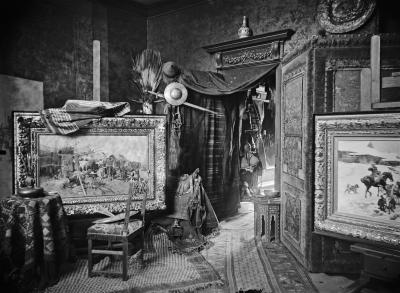
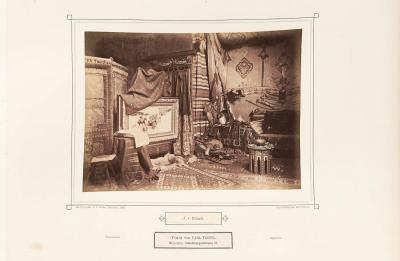

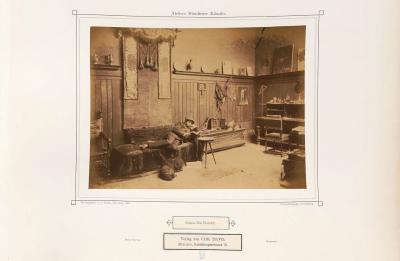






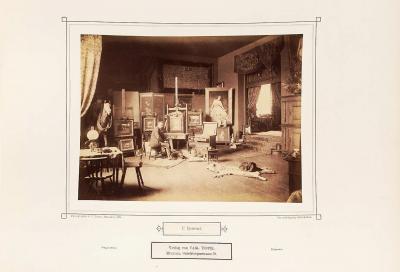




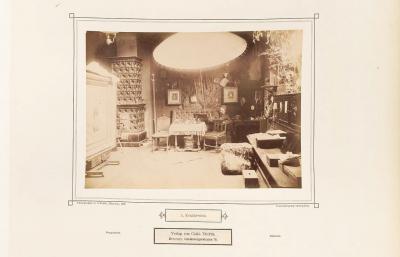


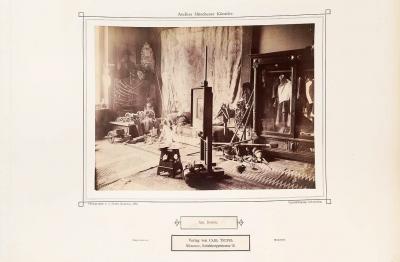



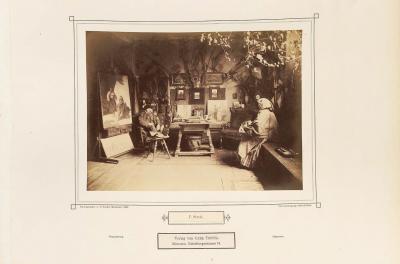

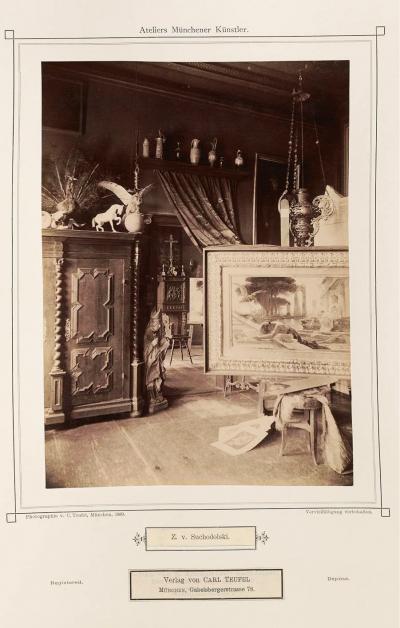

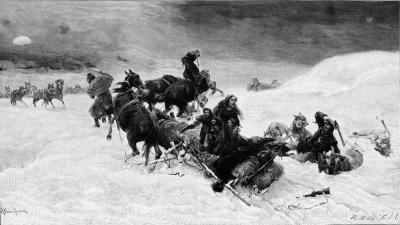


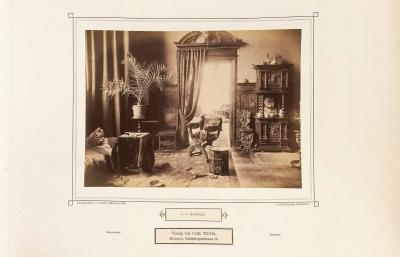



His friend Franciszek Streitt,[80] who traded in Munich under the German version of his name Franz Streitt, can be seen in Teufel’s photograph in his small atelier room, already visibly suffering from a serious illness (Fig. 16). Born in Brody in the Ukraine in 1839, he initially studied at the Technical Academy in Lemberg and at the School of Fine Arts/Szkoła Sztuk Pięknych in Krakow under Władysław Łuszczkiewicz (1828-1900) and Jan Matejko (1838-1893). After scenes from Polish history and literature, he mostly painted genre motifs with a sentimental leaning from the everyday life of tradesmen and peasants as in the picture “Pierwsze kroki/First steps”, which appeared in the “Album of Polish Artists” (see PDF). Streitt also had close ties to the artist colony around Brandt and Wierusz-Kowalski. In his atelier photo, he is sitting opposite the model of a peasant with a basket, which is presumably a dummy in a costume. The display wall is decorated with grasses, emu feathers and stuffed birds, ivy climbs from the window along the ceiling – clearly quite a common decoration which can also be seen in the atelier photograph of the German genre painter Claus Meyer (1856-1919) in neighbouring Georgenstraße[81]. Musical instruments and leather bags also acted as decoration. On a chest in portrait format is the as yet unframed picture “A flower for the hat/Kwiatek do kapelusza“, that is still known today (Fig. 16a). On the easel is the picture that he is currently working on of a young gypsy couple; the seated violin player is also used as an individual image from 1890 (Fig. 16b).
In 1888, Streitt married a Munich painter, but died on Christmas Eve 1890. The Polish author Maria Konopicka (1842-1910), who visited Munich and the ateliers of the Polish artists at the start of a European trip, wrote about the funeral: “In the final day of the old year, the painter Franciszek Streitt was buried in Munich’s northern cemetery. The funeral was sad, his colleagues and his wife, a German, followed the coffin. The coffin enclosed his frail body and his simple spirit, which also distinguished his art work. Simplicity and truth. I don’t know any painters that could express their thoughts or indeed their feelings in just a few strokes of a drawing. This is in fact always his top priority. But how he was able to express these feelings is best evidenced by his “Recruited into the army” – the painful death of a mother and of a young soldier. Once seen, you never forget it.”[82] In 1891, the Munich Art Association put on a retrospective with sixty of the artist's works.
In 1872, Jan Rosen (1854-1936)[83] came to Munich to study after first taking drawing lessons in Dresden, which is where his family had fled after the January Uprising in 1863. Alongside his studies at the Munich Art Academy under the historic and figure painter Alexander Strähuber (1814-1882) and the scupltor, historic and genre painter Ferdinand Barth (1842-1892), he also took private painting lessons with Brandt. Together with his fellow students at the Academy, Henryk Piątkowski (1853-1932),[84] who was represented four years later in the “Album of Polish Painters” by the ancient scene “Rzymianka w kąpieli/Roman lady in the bath” (see PDF), published the Polish student magazine Kolega, and was also active in the student body and the Polish artist colony, and organised choirs and concerts. From 1874, he continued his studies in Paris, and then travelled in Poland before living in Munich again from 1883. From 1888, he had his atelier not far from Brandt at Schwanthalerstraße 32 in the rear building.[85] Under Brandt’s influence, he painted hunting motifs, equestrian scenes and portraits of people on horseback, but became famous for his battle paintings covering the Napoleonic wars and the November Uprising of 1830/31. Wanting to portray every detail as authentically as possible, he did not just study historical sources and literature, instead, following Brandt’s example, he put together a collection of pistols, sabres, uniforms, armour and helmets, model cannons, trumpets and hunting horns, which he lined up meticulously in his atelier (Fig. 14, 15). There was obviously no space for prestigious furniture, so carpets and a few wall hangings were the only things creating a homely atmosphere. Rosen too, who in Teufel’s photograph is sitting in ‘lost profile’ at his easel, appears rather reserved and unassuming.
[80] Detailed biography in the Encyclopaedia Polonica, https://www.porta-polonica.de/de/lexikon/streitt-franciszek
[81] Langer 1992, page 140
[82] Quoted from Zbingniew Fałtynowicz: Gemeinsamer Ursprung, in: Jednodniówka 2008 (see literature), page XVI
[83] Detailed biography in the Encyclopaedia Polonica, https://www.porta-polonica.de/de/lexikon/rosen-jan
[84] Detailed biography in the Encyclopaedia Polonica, https://www.porta-polonica.de/de/lexikon/piatkowski-henryk
[85] Munich address book 1888, Part I, page 274























































































